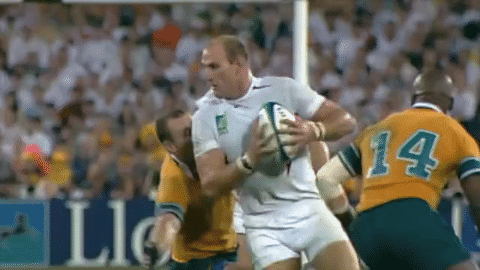England, 2003
England may have been comfortably the best team in the world in 2003 but, in the end, it was a game of inches for Martin Johnson and co. to lift the World Cup. This pioneering shirt was one of them.
It was thanks to the small but significant innovations masterminded by Sir Clive Woodward over his tenure, from nutrition to data analysis, that compounded to ensure England got over the line, just about, against Australia. In fact, so meticulous was his focus on the fine margins, even the England playing shirts were subject to his eye for detail.
2003 was the year the rugby shirts got a radical facelift – they got tight, really tight. Out went baggy cotton and in came polyester blends; gone were traditional collars, with streamlined designs in their place. As professionalism edged its way into every corner of the game, Sir Clive recognised that perhaps a loose-fitting cotton number that added literal kilos when wet through wasn’t the ideal outfit for a high-performance athlete. The era of the functional jersey was here.
The story goes that, despite a 3-29 hammering of Scotland at Murrayfield in the 2002 Six Nations opener, Sir Clive still wasn’t happy. On analysing the match footage Woodward was adamant that Jason Robinson, who had scored twice in the victory, should have had a third if it the scrambling Scottish defenders hadn’t managed to get hold of his shirt. Not wanting his star backfield flyer to be unfounded in the same way come a closer affair, the answer was simple for Sir Clive; make the shirts impossible to grab on to.
While this idea wasn’t entirely the brainchild of Woodward – the All Blacks had already moved towards a more streamlined design, and tight shirts had been tried in Rugby League since 1997 – it was the England boss who took it to the extreme. He instructed Nike to construct a shirt tighter and lighter than anything seen before; working with a British firm, Progressive Sports Technologies, new fabrics were tested under the stress of tackling to see what blend worked best. Debuted in a World Cup warm-up with France, Nike’s dri-FIT technology made the shirt 40% lighter.
However, despite Sir Clive’s push for this breakthrough in sports technology, Nike were also contracted to two other teams for the 2003 tournament, South Africa and France, and so the innovation would have to be shared – luckily, Woodward’s host of other one per cents prevailed. Four years later, the tech was ubiquitous; what was once just a jersey had become a tool necessary for excellence. Who knows, maybe in four years’ time anything but a 7-1 bench will be laughable relic of the past.

